| Back to Back Issues Page |
 |
|
Restore Nature, Issue #24 May 14, 2025 |
HelloRESTORE NATURE NEWSLETTERMay 2025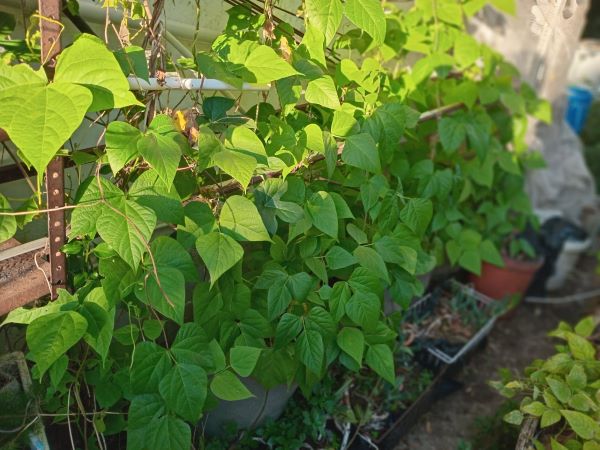
Dear gardeners I'd like to bring up an issue today that may seem a bit of a no brainer, but it helped me reduce my gardening work massively. My mother's garden which is only tended once a fortnight presents a stark contrast to my own garden in which daily work of several hours just never seems to catch up with what needs doing. I believe its an issue in a permaculture garden that doesn't neatly fit any of the 12 principles, or receive enough attention. Perhaps I'm wrong. One of the most important things to do in your garden is to ensure sufficient capacity to be able to smoothly accomplish your main tasks. Like the proverbial elephant in the room, not having enough capacity for your main tasks can be a huge design failing that is easy to overlook while distracted by other things like polyculture and companion planting that seem more interesting. However without sufficient space for your tasks, you are constantly squeezing activities and projects into a space that is too small. This can be hard work and involve much unproductive time. My aha moment came when I managed a garden with sufficient capacity. What a difference it made and how easy maintance became without the constant juggling. 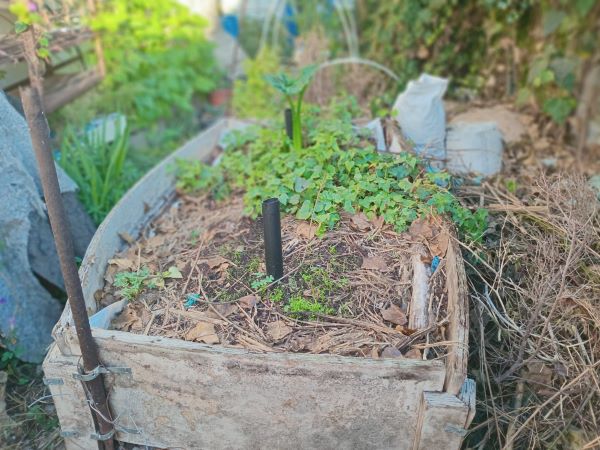 In a small garden one can be constantly tripping over brush piles and other organic garden waste. I realized that composting and organics storage capacity was very important to my ability to reduce labour. A large area for laying non thorny branches was cleared behind the old vegetable beds, which beds sadly didn't last too well, being made of chip.
Chop and drop may seem like a solution to not having to move garden waste around, but I've three very thorny trees which form a large part of my organic waste volume, and if you drop these branches on beds sooner or later you will impale yourself while planting. The second reason is that I've found that chop and drop works better at a scale where slashing with a machete or trimmer can be done. Clipping the plants one by one at the soil line in a small garden is a lot of labour and they resprout in days. So I forego the practice.
In a small garden one can be constantly tripping over brush piles and other organic garden waste. I realized that composting and organics storage capacity was very important to my ability to reduce labour. A large area for laying non thorny branches was cleared behind the old vegetable beds, which beds sadly didn't last too well, being made of chip.
Chop and drop may seem like a solution to not having to move garden waste around, but I've three very thorny trees which form a large part of my organic waste volume, and if you drop these branches on beds sooner or later you will impale yourself while planting. The second reason is that I've found that chop and drop works better at a scale where slashing with a machete or trimmer can be done. Clipping the plants one by one at the soil line in a small garden is a lot of labour and they resprout in days. So I forego the practice.
The thorn branches are left for years under trees until they are dry enough to be burned or trampled to form hugel beet beds. I needed more capacity for drying out thorn branches but also for composting. And this designated space is what my mother's garden had in abundance. In her garden I organized things so that plant material could be moved around and moved only once to its final destination. In my small garden I had too many spots which were compromises in terms of location. They were temporary spots and before I could put the areas to a new use, lots and lots of painful clipping and brush removal were required. 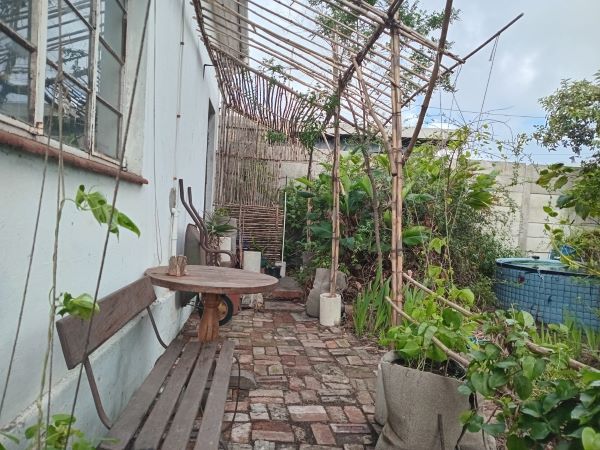 Regarding the omnipresence of thorny brush piles, my veranda under the bean trellis had to be cleared of a 2 meter high pile of thorns which found itself deposited there before I could start building the trellis. It delayed the project by several weeks. A similar mess drowned my clay oven. Different people use the garden and have different priorities and this will happen when people don't know what to do with thorn branches. Every time I start a garden project its like wading through this pile of thorns which take days and days to render down.
Regarding the omnipresence of thorny brush piles, my veranda under the bean trellis had to be cleared of a 2 meter high pile of thorns which found itself deposited there before I could start building the trellis. It delayed the project by several weeks. A similar mess drowned my clay oven. Different people use the garden and have different priorities and this will happen when people don't know what to do with thorn branches. Every time I start a garden project its like wading through this pile of thorns which take days and days to render down.
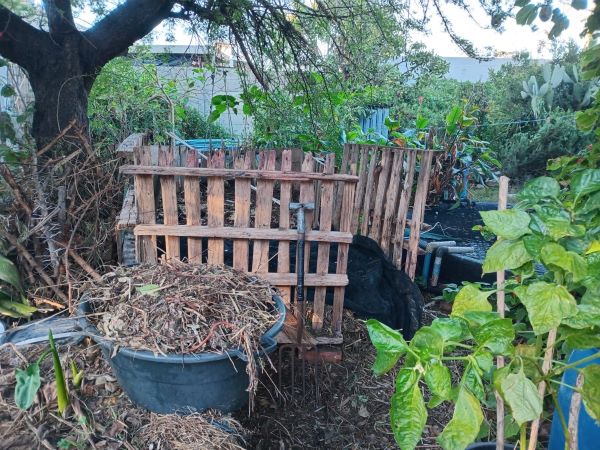
I've now made a large area for storing thorn branches out of the way of garden activities. It is next to a very large garden waste composter made of pallets of which the capacity is about 4 cubic meters or more. Sometimes increasing capacity can be about increasing speed. I've installed a metal bin brought from the old place for all the kitchen waste and its so quick to use compared to lifting the mustard coloured carpets you see in the mid ground, depositing the stinky bucket's contents and covering with newspapers and cardboard, plastic and then replacing the carpet again. Because of the speed of making deposits I don't need to store up kitchen waste in a 20L bucket but can pop out every day with the 5L bucket and empty it. Its much less smelly. The worms can elso get access to the kitchen waste without being hunted by rodents. 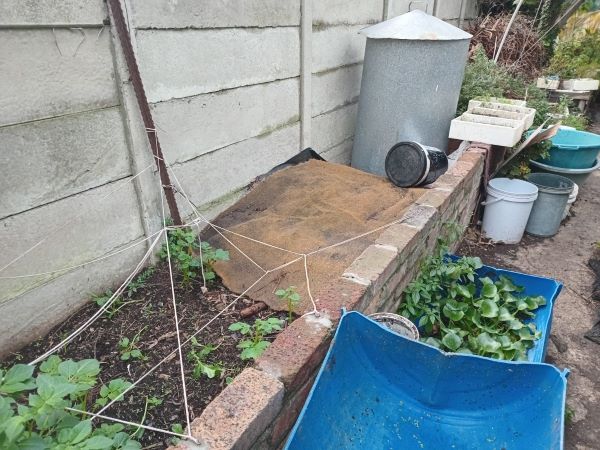 Every time I have a spare moment I can work on the composting system... scattering browns, chopping up greens, without a colossal compost moving operation waiting for me.
Every time I have a spare moment I can work on the composting system... scattering browns, chopping up greens, without a colossal compost moving operation waiting for me.
A solution for the organic wasteCOPY AND PASTE THE CAPACITY OF WASTEThe solution I've used for my piles of organic garden waste, difficult worm bin and composting area that was always too small, was to take a look at the piles that got in my way, and set aside a space slightly larger, or shrink the capacity of things that had too much space. My overflowing composter had a capacity of a cubic meter, and there was always stuff waiting to be processed and added to it as it went down, so I set aside roughly 3 cubic meters for composting. The wormery was way too large for our kitchen waste, and very inconvenient to use, and so I shrunk it down to the the one flip metal bin. In true permaculture style I'll continue to fine tune this as its capacity is tested. 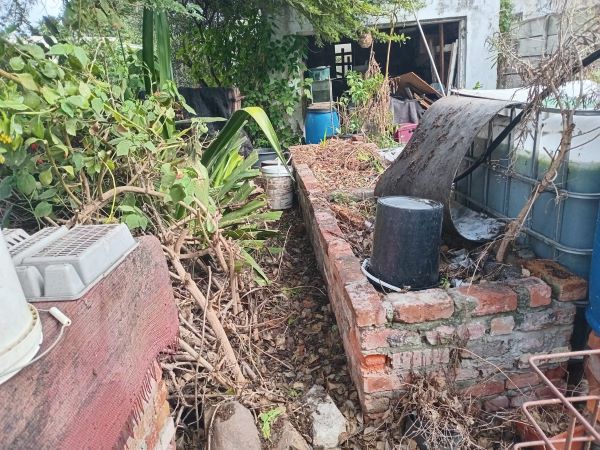
Solutions for growing capacityREPEAT WHAT WORKSIn a small garden creating capacity for growing is not so easy. The beans growing up strings on the north side of the house did very well in the past, so I created more trellising on the west side. Thus I've repeated and multiplied to create a lot of space for growing beans on the house walls, the bean trellis for sitting under being recently completed. The house is covered in a green wall of beans even at this late season. Some things I still need greater capacity for are growing root and leaf vegetables. Thus I pruned the massively over grown walkway to the brick beds above. The overgrowth of shrubs made the beds inaccessible and unusable as they are hemmed in on the other side by Koi sales tanks for small fry. These highly productive brick beds fed by kitchen grey water produced magnificent leaf harvests in the past that were adequatel for a three person household. 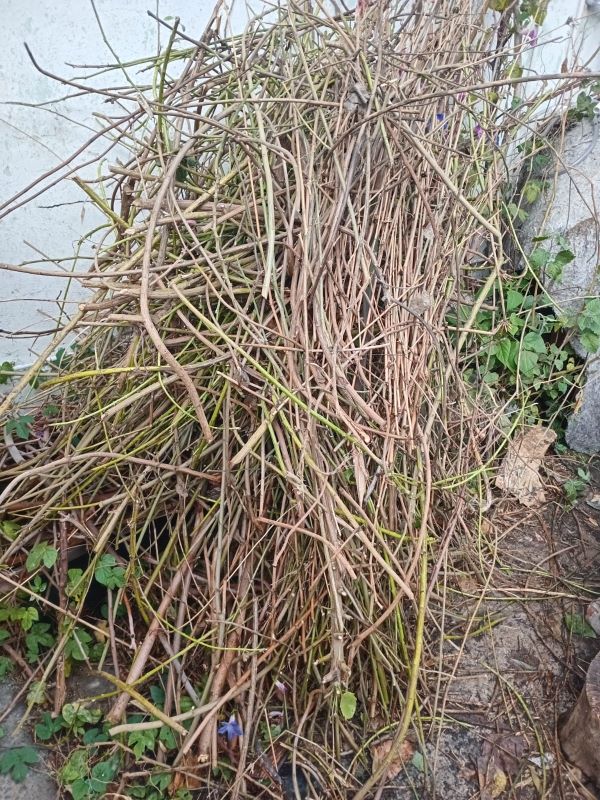 That left providing space for root vegetables. I cleaned up a lot of canes from the trimming of shrub overgrowth for making two new woven vegetable beds in the front garden. This will add 200% to my root bed capactiy. Dead hedges may be all the rage at the RHS shows, but they are labour intensive. Fortunately I love their appearance so much I don't mind. The front garden is ideal for potato, sweet potato and onions. We pass it every day and can see if watering or weeding is needed, but otherwise its neglected.
That left providing space for root vegetables. I cleaned up a lot of canes from the trimming of shrub overgrowth for making two new woven vegetable beds in the front garden. This will add 200% to my root bed capactiy. Dead hedges may be all the rage at the RHS shows, but they are labour intensive. Fortunately I love their appearance so much I don't mind. The front garden is ideal for potato, sweet potato and onions. We pass it every day and can see if watering or weeding is needed, but otherwise its neglected.
I don't think this is remotely enough area given to calorie rich food plants and I feel I can't achieve enough bed space for vegetables in such a small garden to be 'self sufficient', but I'm aiming for the best I can achieve while still leaving some of the garden wild and shrubby, for the birds. The birds are very important to me. I delight in their song and its so precious to me that I can still hear them. There are times of day when their chorus is heavenly. This is about it. The things that really bothered me are slowly being ironed out. Please let me know about your strategies for making gardening work flow better. We can learn a lot from each other. Topic suggestions welcomeYou may write to me anytime at the website greenidiom by filling out a comment. You can also use my webmail (website mail) address greenidi@greenidiom.com. Have you missed anything ?Please go to back issues right below if you want to catch up with what I've sent thus far as preamble for the course, as well as previous newsletters. |
| Back to Back Issues Page |